Trees as Linked Lists in Common Lisp
Published: February 23, 2010If you are starting to learn Common Lisp, and have already read the chapter about “Cons” from an introductory book (also called cons cells), then you could try the following exercise. How to represent a tree using nothing but conses; and abstract that implementation with functions to create and traverse the tree.
PLEASE NOTE, that if you need to represent trees in a production program you shouldn’t use lists as described here unless you have a good reason. This is only an exercise in understanding how cons cells work.
1. A Tree
Suppose we would like to represent the following tree in memory, using only lists (which are created by chaining conses). You should already know how a cons is created and what parts constitute one. If not, go back to an introductory book on Common Lisp.

This tree can be represented as a set of linked lists, like in the following diagram:

The natural way to represent the previous tree as a Common Lisp list is like the following:
(1 (2 6 7 8) 3 (4 (9 12)) (5 10 11))
The first element of a list is the root of that tree (or a node) and the
rest of the elements are the subtrees (more nodes). For example, the
subtree (2 6 7 8) is a tree with “2” at its root and the elements “6 7
8” as its children.
Exercise
How would you draw a diagram of the cons cells of the previous list? Compare it to the figure below.
.
.
.
.
.
.
.
.
.
.
The cons cells that build up the list above can be drawn like this:
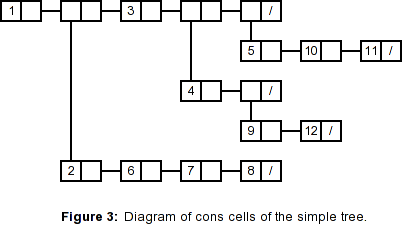
2. Another representation of the Tree
The list representing the tree shown above is intuitive and easy to
understand, however there’s a slight inconvenience. A subtree can be
represented as a cons that directly contains the data in it’s car
position, like in the case of “3”, or as a cons that refers to another
cons that starts a proper list, like in the case of (2 6 7 8).
There’s no consistency, when you need to access the data contained in a node, you must first check if the car position of the cons refers to a list, in which case you have to access that list to get the data.
Also, in the example list above, we are storing numbers in the nodes of the tree. What if you wanted to reference any kind of data from a node?, including a list?
Exercise
How would you represent a single node of a tree, so that the methods to access the data, the children, and the next sibling are always the same?, how could the node reference any kind of data, including other lists?
Compare it to the representation given below.
.
.
.
.
.
.
.
.
.
.
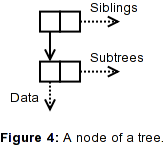
There could be more than one way to represent a node, but in the rest of this small article we are going to represent them like in the figure above.
A tree node consists of two conses, the cdr of the first cons refers to the siblings of the node, while the cdr of the second cons refers to the subtrees (children) of the node. The car of the first cons refers to the second cons, while the car of the second cons refers to the data stored in this node, which can be any kind of object.
Using this node representation, the example tree given in Figure 1 would be displayed by Common Lisp as the following list. Can you see why?
((1 (2 (6) (7) (8)) (3) (4 (9 (12))) (5 (10) (11))))
Exercise
How would you draw a diagram of the cons cells of the previous list? Compare it to the figure below.
.
.
.
.
.
.
.
.
.
.
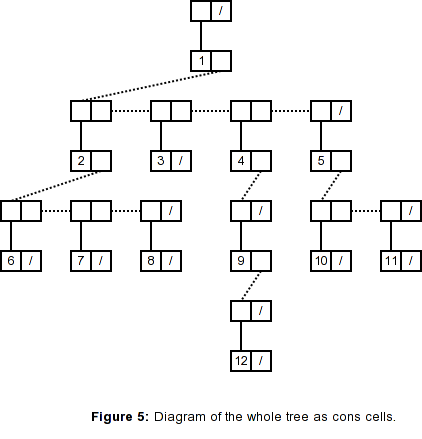
3. The API
These are the functions that we are going to define for creating and traversing the nodes of a tree.
(defun make-tree (data)
"Creates a new node that contains 'data' as its data."
...)
(defun add-child (tree child)
"Takes two nodes created with 'make-tree' and adds the
second node as a child of the first. Returns the first node,
which will be modified."
...)
(defun first-child (tree)
"Returns a reference to the first child of the node passed in,
or nil if this node does not have children."
...)
(defun next-sibling (tree)
"Returns a reference to the next sibling of the node passed in,
or nil if this node does not have any siblings."
...)
(defun data (tree)
"Returns the information contained in this node."
...)
Notice that the function add-child will modify the node passed as the
first argument, it is a destructive function, it has side effects.
If you haven’t read about destructive or side-effecting functions, then you should go back and continue reading your book on Common Lisp.
Exercise
Given the structure of a node as shown in Figure 4 above, come up with the code for the functions outlined above.
Compare your code to the solutions given below.
Test your code with the following usage example:
(let ((one (make-tree 1)))
(add-child one (make-tree 2))
(add-child one (make-tree 4))
(add-child one (make-tree 5))
(let ((two (first-child one)))
(add-child two (make-tree 6))
(add-child two (make-tree 7))
(let ((four (next-sibling two)))
(add-child four (make-tree 9))
(add-child (first-child four) (make-tree 12))))
one)
=> ((1 (2 (6) (7)) (4 (9 (12))) (5)))
.
.
.
Code for the functions outlined above
I’m going to skip showing a code for the function add-child for now, we
are going to discuss it in the next section.
The first function make-tree just needs to create the two conses as
depicted in Figure 4, and place the data in the correct place.
(defun make-tree (data)
"Creates a new node that contains 'data' as its data."
(cons (cons data nil) nil))
Similarly, for the other functions, we just need to follow the correct cells as suggested in Figure 4.
(defun first-child (tree)
"Returns a reference to the first child of the node passed in,
or nil if this node does not have children."
(cdr (car tree)))
(defun next-sibling (tree)
"Returns a reference to the next sibling of the node passed in,
or nil if this node does not have any siblings."
(cdr tree))
(defun data (tree)
"Returns the information contained in this node."
(car (car tree)))
Easy, is it not?. Were you checking for null trees? That is, where you doing something like this?
(defun first-child (tree)
(if (null tree)
nil
(cdr (car tree))))
or
(defun first-child (tree)
(if (null (cdr (car tree)))
nil
(cdr (car tree))))
Well, don’t, that’s Java/C++ thinking. Notice that (car nil) evaluates
to nil, and similarly, (cdr nil) evaluates to nil too.
However, trying to pass an atom or other object that is not a cons
to either car or cdr is an error. For example (first-child 3)
would cause an error.
You could try to guard against that redefining first-child like this:
(defun first-child (tree)
(when (listp tree)
(cdr (car tree))))
However, I wouldn’t do that, because I think that signalling an error on
a function call like (first-child 3) is the correct thing to do. The
user of the function is the one that is committing an error, not the
implementor of the function.
4. First approach to add-child
There are a few ways you could have implemented the function add-child,
let’s consider an example that at first sight might look fine.
(defun add-child (tree child)
(setf (car tree) (append (car tree) child))
tree)
Remember that the cdr of the second cons (car tree) refers to the
children of the node, so that when we do (append (car tree) child) we
are appending child to the end of the list of conses that start
with the one in (car tree). Since append does not modify any of its
arguments and instead returns a fresh “consed” list (a new copy), we
have to capture it again with (setf (car tree) ...).
By the way, the setf line can be replaced with this line,
(rplaca tree (append (car tree) child))
rplaca stands for “replace car”, and it replaces the car of the first argument with whatever the second argument evaluates to.
Now, let’s try building the whole tree depicted in Figure 1; the following code can accomplish that.
(let ((one (make-tree 1)))
(add-child one (make-tree 2))
(add-child one (make-tree 3))
(add-child one (make-tree 4))
(add-child one (make-tree 5))
(let ((two (first-child one)))
(add-child two (make-tree 6))
(add-child two (make-tree 7))
(add-child two (make-tree 8)))
(let ((four (next-sibling (next-sibling (first-child one)))))
(add-child four (add-child (make-tree 9) (make-tree 12)))
(let ((five (next-sibling four)))
(add-child five (make-tree 10))
(add-child five (make-tree 11))))
one)
=> ((1 (2 (6) (7) (8)) (3) (4 (9 (12))) (5 (10) (11))))
By visually inspecting the resulting list you can see that the tree is
being built correctly. But you might wonder why juggle with first-child
and next-sibling with nested let bindings, why not create the nodes
that we need to refer more than once in the first let binding.
(let ((one (make-tree 1))
(two (make-tree 2))
(four (make-tree 4))
(five (make-tree 5)))
(add-child one two)
(add-child one (make-tree 3))
(add-child one four)
(add-child one five)
(add-child two (make-tree 6))
(add-child two (make-tree 7))
(add-child two (make-tree 8))
(add-child four (add-child (make-tree 9) (make-tree 12)))
(add-child five (make-tree 10))
(add-child five (make-tree 11))
one)
=> ((1 (2) (3) (4) (5 (10) (11))))
What??, the children of nodes “2” and “4” were lost, but somehow the children of node “5” were added correctly. There’s no difference in the way we create nodes 2, 4 and 5, and there’s no difference in how we add children to them either. What’s going on?
Exercise
This is where you will really test your understanding of how conses work
and how references to objects in Common Lisp work. Try to figure out why
the function add-child as used above is failing to correctly build the
tree that we want.
Drawing the cons cells after each operation will be helpful.
You will also need to be sure to understand how append works.
.
.
.
.
.
.
.
.
.
.
5. Understanding what is going wrong
To understand what is going wrong, let’s see what happens after let creates the bindings, but before any form inside the let body is evaluated.
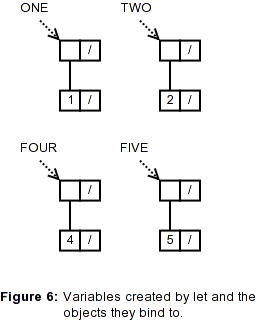
We have four variables bound to four tree nodes. Then after evaluating the
form (add-child one two) we have the following objects.
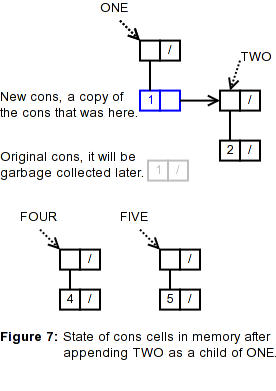
The function append does not modify any of its arguments, and therefore to be able to build a new list it has to create new conses copying the top list structure of all the lists it has been passed in as arguments, except for the very last list, which will be just pointed to by the second to last list.
After (append (car tree) child) has created the new list, we point to it
by doing (setf (car tree) ...), thereby losing the reference to the
original cons that was there (shown in grey in the above figure).
Please Note, the figure above may create a confusion. I’ve been drawing the numbers inside the cons for simplicity, but this is not very accurate. The two components of a cons (the car and the cdr) can refer to any type of object, and these objects may live in other parts of the memory.
Sometimes an implementation may store integers and other data types directly inside the cons, but you shouldn’t care or depend on this.
Functions like append only copy the “list structure”, it will never copy the data that a cons refers to. (But make sure to understand the difference between append and copy-tree, refer to your Common Lisp book or the HyperSpec.)
A more accurate depiction of the cons cells and the objects they refer to would look like this.
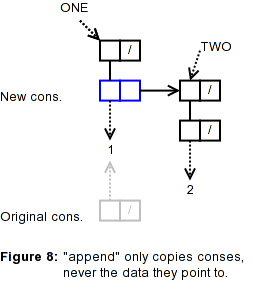
However, I’ll continue drawing the numbers inside the cons for simplicity.
OK, so moving on, after the form (add-child one (make-tree 3)) has been
evaluated, we have the following situation.
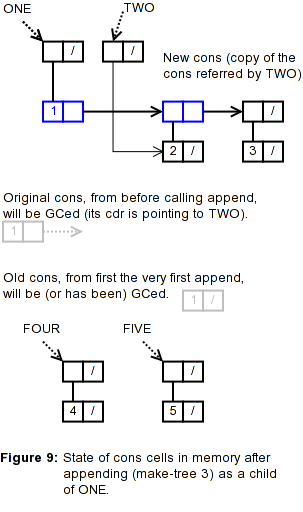
append copied the top list structure of the first list it had as an argument, this new list points to the last list, the node “3”. “Top list structure” means that append will only copy the conses that it reaches by following the cdrs of each cons; it will never go down the car of any cons (that’s what copy-tree would do).
The conses of the new list are shown in blue, while the original cons that was holding the value “1” and pointing to TWO is shown in grey. Since nothing is pointing to this grey cons, it may be garbage collected.
Now let’s see what happens after evaluating (add-child one four).

Again, we see the new copies of conses marked in blue, while the original conses are marked in grey. Since those grey conses can’t be reached anymore, they may eventually be garbage collected.
And, after evaluating (add-child one five) we have the following.
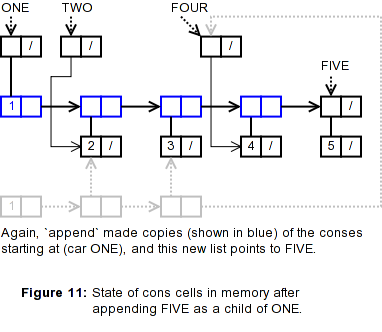
Again, the blue conses are the copies made by append and the grey conses here were the blue conses of Figure 10. Can you see why there’s only three grey conses (which can be GC) and four new blue conses?
So far everything seems to be working ok. But now comes the interesting part.
Exercise
From the state of cons cells depicted in Figure 11 above, can you see
what will happen after the form (add-child two (make-tree 6)) is
evaluated?, can you see where lies the problem?. Drawing the conses
could be helpful.
Compare it to the figure below.
.
.
.
.
.
.
.
.
.
.

Let’s recall the definition of add-child:
(defun add-child (tree child)
(setf (car tree) (append (car tree) child))
tree)
We can see that we are calling append on (car tree) and child,
which correspond to (car TWO) and the value of (make-tree 6).
Therefore it’s easy to see that append is creating a copy of the
cons in (car TWO), returning a new list. Finally, setf sets the
(car TWO) to point to this new list, completely separating TWO from
the original tree starting with ONE.
Now we have two disjoint trees, one starting at the node pointed to by
ONE and the other starting at the node pointed to by TWO. If we keep
adding children to TWO, they will not be reachable from ONE. Likewise
if we add children to the node FOUR.
Can you see why there’s no problem in adding children to the node FIVE?
6. A correct version of add-child
The problem with the definition of add-child above is that while it is
defined to modify the argument tree, it’s actually only modifying part
of it, and making new copies of other parts of tree (its children).
In other words, we should consider that the argument tree refers not
only to a single node, but to a whole “tree” with subtrees. Of course
the fact that we named the argument tree is to remind us of that.
We have to be always careful when designing our functions, and be clear if they will modify their arguments and how; or otherwise specify that our function will be completely side-effect free.
When we say that the function add-child will modify the first argument
to add the second argument as a child of it, then it must do that, but do
it to the whole conceptual tree.
The other alternative is to build a side-effect free add-child, which
will create a new copy of the whole tree with the child appended, and
leave the responsibility of capturing that new tree and updating any and
all references to it or parts of it, to the user of our function.
So how do we correct add-child to do the correct thing?. We know that we
can’t use append because it creates new copies of the children that
tree had. Knowing that, the solution is easy, we just need to use the
destructive version of append, which is called nconc.
nconc won’t create any copy of anything, and instead will modify it’s arguments so that they are linked in a single list, much like what append does.
(defun add-child (tree child)
"Takes two nodes created with 'make-tree' and adds the
second node as a child of the first. Returns the first node,
which will be modified."
(nconc (car tree) child)
tree)
nconc will modify the cdr of the second cons of tree to add
the child if it had not previous children; otherwise it will modify the
last node in the list of children of tree, and link the child to it.
Can you see why it’s just (nconc (car tree) child) and there’s no need
to use setf?
But be very careful, nconc is the only destructive function for which you don’t need to capture it’s result with setf. When you are using other destructive functions like nreverse you must always capture the result with setf.
7. Traversing the tree
Finally, it’s difficult to see the returned list and interpret it. Let’s try to create a function to traverse the tree as the last exercise.
(let ((one (make-tree 1))
(two (make-tree 2))
(four (make-tree 4))
(five (make-tree 5)))
(add-child one two)
(add-child one (make-tree 3))
(add-child one four)
(add-child one five)
(add-child two (make-tree 6))
(add-child two (make-tree 7))
(add-child two (make-tree 8))
(add-child four (add-child (make-tree 9) (make-tree 12)))
(add-child five (make-tree 10))
(add-child five (make-tree 11))
;; Print the contents of the tree,
(traverse one)
;; and return it.
one)
If we input the above into the REPL, we should get the following output.
Data: 1 Children: (2 3 4 5)
Data: 2 Children: (6 7 8)
Data: 6
Data: 7
Data: 8
Data: 3
Data: 4 Children: (9)
Data: 9 Children: (12)
Data: 12
Data: 5 Children: (10 11)
Data: 10
Data: 11
((1 (2 (6) (7) (8)) (3) (4 (9 (12))) (5 (10) (11))))
Notice that the list ((1 (2 ...) is the value of one returned by the
let form, while the information before it is being printed by
(traverse one).
Exercise
Write the function traverse so that it generates the output shown above.
Compare it to the solution given below.
Tip: you can use the "~v@T" directive to the format function to
move the cursor forward. For example:
(format t "~v@TFoo" 2)
=> Foo
(format t "~v@TBar" 4)
=> Bar
(format t "~v@TFoo" 6)
=> Foo
.
.
.
.
.
.
.
.
.
.
Let’s build the solution in steps. First we should print the node data:
(format t "~&~v@TData: ~A" padding (data tree))
The parameter padding will tell format to indent the line a certain
number of columns. We’ll see how to calculate that later. The "~&"
directive tells format to print a newline only at the beginning of a
line.
We also need to print the children of the node, on the same line, but only if there are children to print.
(format t "~&~v@TData: ~A" padding (data tree))
(when (first-child tree)
(format t " Children: ~A" (first-child tree)))
But wait, that’s not correct, it would print the whole tree of the children of node, like this:
Data: 1 Children: ((2 (6) (7) (8)) (3) (4 (9 (12))) (5 (10) (11)))
We only want the data in the nodes of the direct children of the node, as a list. We can use the maplist function for that. maplist applies a function to successive sublists of a list.
(format t "~&~v@TData: ~A" padding (data tree))
(when (first-child tree)
(format t " Children: ~A"
(maplist #'(lambda (x) (data x))
(first-child tree))))
Now let’s wrap this in a function.
(defun traverse (tree &optional (padding 0))
(format t "~&~v@TData: ~A" padding (data tree))
(when (first-child tree)
(format t " Children: ~A"
(maplist #'(lambda (x) (data x))
(first-child tree)))))
OK, now that we have printed the data of the node and a list of the children, we have to repeat this process for each of the children of this node, and they should be printed indented below the current node.
Since we already have the code to print the node and a list of its
children, we will reuse this function and do a recursive call. One
important thing to keep in mind when writing a recursive function is write
a test for ending the recursion. In this case the recursion must end when
the parameter tree is nil.
(defun traverse (tree &optional (padding 0))
(when tree
(format t "~&~v@TData: ~A" padding (data tree))
(when (first-child tree)
(format t " Children: ~A"
(maplist #'(lambda (x) (data x))
(first-child tree))))
(traverse (first-child tree) (+ padding 3))))
We can see above how the padding is being incremented, in this case by
3 columns. Since the parameter padding is optional, in the first
invocation (traverse one) the padding will be zero, and then it will
be incremented by 3 on each recursive invocation.
But wait, the above code will only print the leftmost nodes in the tree, we still need to print the siblings of the nodes. That is very easy.
(defun traverse (tree &optional (padding 0))
(when tree
(format t "~&~v@TData: ~A" padding (data tree))
(when (first-child tree)
(format t " Children: ~A"
(maplist #'(lambda (x) (data x))
(first-child tree))))
(traverse (first-child tree) (+ padding 3))
(traverse (next-sibling tree) padding)))
Since the siblings should be printed at the same level as the current
node, the padding is left unmodified.
:EOF
And that’s it. I hope this helped you get a better grasp of how conses work.